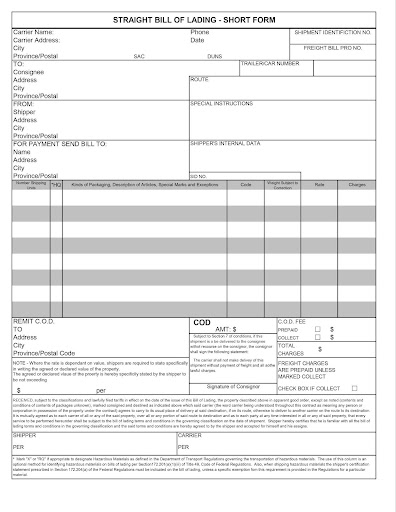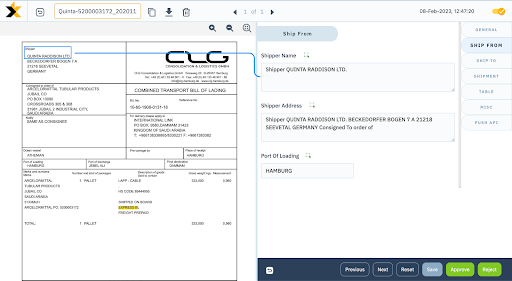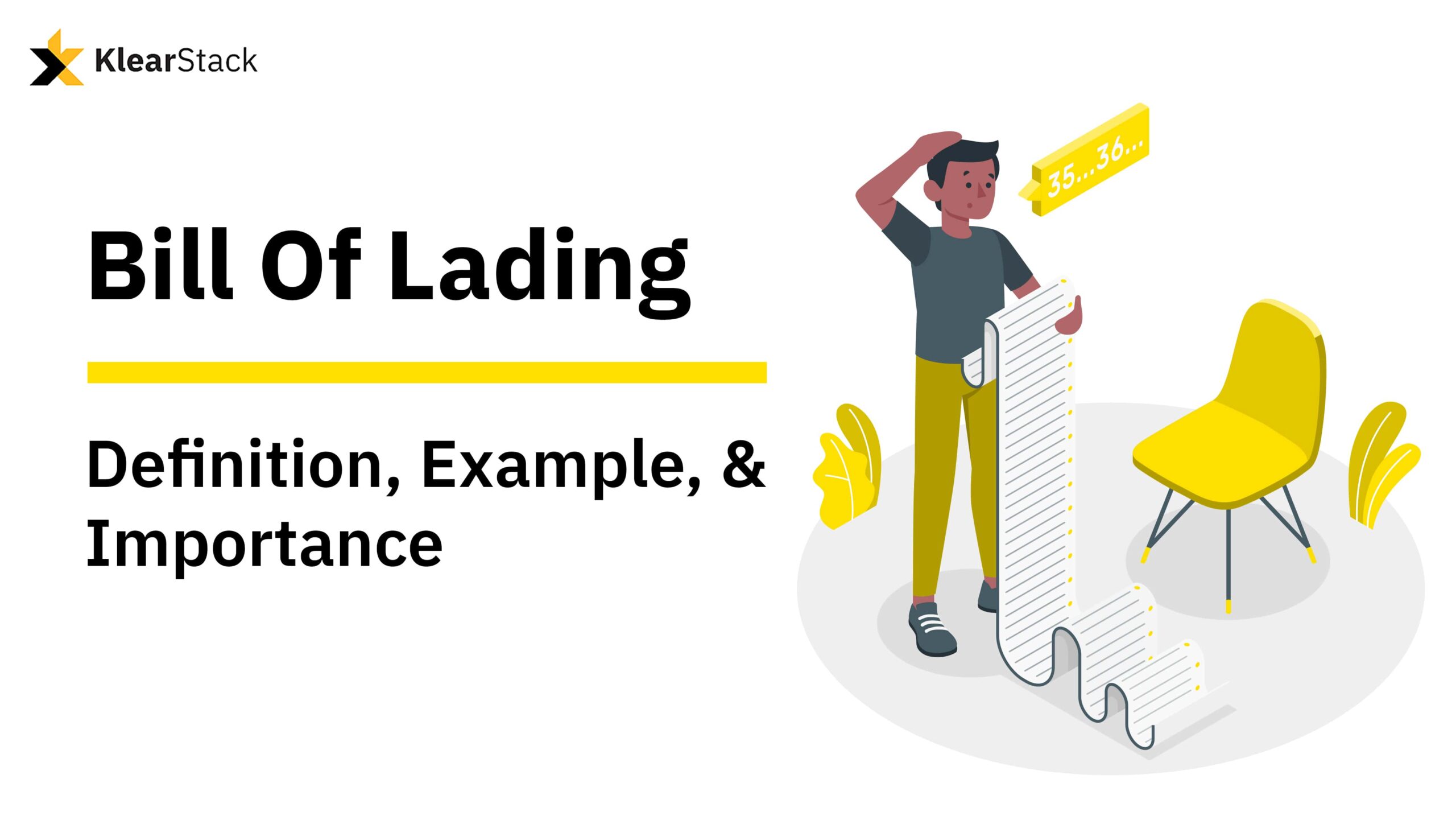Are you new to export/import or international trade business? If yes, then you must know about one of the critical documents in the export/import business i.e. Bill of Lading (aka B/L, BoL).
Say you’re a business owner in the United States importing a shipment of electronic devices from a manufacturer in China. The manufacturer loads the products onto a container ship, and a bill of lading is issued.
Now, imagine there’s a delay at the destination port due to customs procedures or other logistical issues. To clear customs and take delivery of your goods, you need to present the bill of lading. Without it, authorities may not release the shipment.
In this scenario, the bill of lading demonstrates that you are the rightful owner of the goods and have the authority to receive them. It helps with a smooth transfer of ownership from the seller to the buyer, throughout the shipping process.
What is a Bill of Lading?
A bill of lading is a legal document issued by a carrier to the shipper (the person sending the goods) acknowledging the details of the goods being carried. For example –
- What’s the quantity of the goods?
- Who’s the ultimate consignee?
- What’s the destination of the goods, etc.
To avoid confusion, it’s important to first understand the meaning of each the following terms:
- The carrier is referred to as the transportation company. It is someone who moves the cargo (for example: CMA CGM, Maersk).
- The shipper is someone who packs the shipment. This could involve your manufacturer or supplier.
- The buyer/consignee is someone who receives the shipment. This could be the company or manufacturer who will be using your shipped goods.

How does a Bill of Lading work?
Are you curious to know about how does Bill of Lading (BoL) works? Here’s a complete step-by-step breakdown of it.
Step 1: Preparing for Shipment
The shipper ensures that the goods are ready for shipping to the buyer.
Step 2: Issuing the Bill of Lading
The carrier issues a BoL to the shipper, a document containing details about the shipped goods. This document is signed by an authorized person from the carrier’s company.
Step 3: Delivering the BoL
As the shipment progresses towards the consignee’s destination, the shipper delivers the original signed BoL document to the consignee.
Step 4: Asserting Ownership with the BoL
The Bill of Lading serves as the document of title for the goods. Upon the goods’ arrival at the destination, the consignee claims ownership by presenting the original BoL.
When you place an order for goods from an international supplier, the Bill of Lading steps in as a crucial receipt.
Within this bill of lading form, it intricately outlines all the parties involved in the export/import process, holding each accountable for their designated responsibilities. In the unfortunate event of any loss, this document becomes instrumental in raising concerns and assigning responsibility to the relevant parties involved.
Bill of Lading Form

Image Source: Download Straight BoL Template Form
What is in a Bill of Lading?
A bill of lading template contains the following elements:
- Names and addresses of the shipper, consignee, and carrier.
- Description of goods, including type, quantity, and condition.
- Port of loading and destination details.
- Vessel information: name, voyage number, and identification.
- Freight terms, specifying prepaid or collect and responsibilities.
- Date of shipment when goods are handed to the carrier.
- Terms and conditions outlining rights and obligations.
- Notations or special instructions for handling or delivery.
- Signatures and seals of authorized representatives.

What is the purpose of Bill of Lading?
Here’s a breakdown of the purpose that a bill of lading has in international trade:
- It acts as a receipt of goods: The BoL confirms that the carrier has taken possession of the specified goods and is now responsible for their safe transportation.
- It is a document of title to the goods being shipped: Ownership of the goods is transferred upon endorsing (signing) the bill of lading over to another party. This transfer is essential for various trade and financial transactions.
- It is the evidence of the contract of the carriage between shipper and carrier: This document specifies crucial details such as the type and quantity of goods, the agreed-upon freight terms, the destination, and any special instructions or conditions.
Bill of Lading Example
In this example, the bill of lading includes essential information about the shipment, such as the parties involved, description of goods, ports, vessel details, and terms and conditions.
As the buyer, you can claim ownership of the goods upon arrival at Port City B by presenting this bill of lading to the relevant authorities.
Issued by XYZ Shipping Company
Shipper (Sender): ABC Electronics Ltd
Consignee (Receiver): John Doe Electronics
Carrier: XYZ Shipping Company
Description of Goods:
- 100 units of Smartphones
- Packed in cartons
- Total weight: 500 kg
Port of Loading: Port City A
Destination Port: Port City B
Vessel Information:
- Vessel Name: Ocean Voyager
- Voyage Number: OV123
Freight Terms: Prepaid
Date of Shipment: January 15, 2023
Terms and Conditions:
- The carrier is responsible for the safe transportation of the goods from Port City A to Port City B.
- The consignee (John Doe Electronics) has ownership rights upon presentation of this bill of lading at Port City B.
Special Instructions: Handle with care.
Signature and Seal:
(Signature)
(Official Seal)
Types of Bill of Lading
There are several types of BoL, each suited for different trade scope and usage.
|
| Inland Bill of Lading |
Scope: |
Domestic transport within a single country. |
|
Usage: |
Typically for shipments within the borders of a nation. | ||
|
2. | Scope: | Covers the sea transport of goods. | |
| Usage: |
Common in international trade, serving as a crucial document for sea shipments. | ||
| 3. | Scope: | Encompasses multiple modes of transport (e.g., sea and land). | |
| Usage: |
Provides a unified document for the entire journey, facilitating smooth transitions between different carriers. | ||
|
4. | Transferability: | Can be transferred to another party. | |
| Usage: |
Offers flexibility as ownership can change hands during the shipment process. | ||
|
5. |
Nonnegotiable Bill of Lading | Transferability: | Issued to a specific consignee and not transferable. |
| Usage: |
Provides less flexibility in ownership transfer. | ||
|
6. |
Claused Bill of Lading | Content: | Contains notations indicating discrepancies or issues. |
| Usage: |
Alerts stakeholders to problems with the goods during transport. | ||
|
7. |
Clean Bill of Lading | Content: | Certifies that the goods are in apparent good condition. |
| Usage: |
Provides assurance of the quality and condition of the shipped goods. | ||
|
8. |
Uniform Bill of Lading | Format: |
Follows a standardized layout. |
| Usage: |
Enhances consistency and clarity in documentation, often applied in domestic shipments. |
Different types of shipments may require specific types of bills of lading to comply with legal and regulatory standards. So, you need to choose an appropriate bill of lading.
How to Choose an Appropriate Bill of Lading?
The type of BoL you choose can influence how risks & responsibilities are allocated between the parties involved. On the other hand, picking the right one will reduce the likelihood of disputes upon the agreed terms & conditions.
So, the question is—how to choose an appropriate BoL?
The key is to assess your transferability needs, trade terms, and the nature of goods.
- What is the nature of my goods and mode of transportation?
- Do I need the flexibility of transferring ownership during the shipment process? (If so, a negotiable bill of lading might be more suitable).
- What trade terms (Incoterms) am I using? (Certain terms may be better suited to specific types of bills of lading).
Additionally, you can even consider and re-assess the risk factors involved in your shipment. For example, a clean bill of lading may be preferred for goods in good condition, while a claused bill of lading may be necessary if there are discrepancies.
These questions will allow you to make informed decisions when selecting the appropriate bill of lading. Thus, minimizing risks, and facilitating smoother transactions.
Automate Your Bill of Lading with KlearStack. Simplify the Nuances of Trade Terms Today!
KlearStack is a smart intelligent document processing solution to help you automate your BoL needs.
The automated tool lets you set up predefined rules & formats to check whether details like names, addresses, and product descriptions are accurate.

What’s worth to know is that it isn’t bound by any specific template. You can extract data in any format—be it in tables, or line items. Additionally, you can customize the output of the extracted tables.
With the help of KlearStack, you can–
✓Cut costs up to 70%.
✓Achieve 99% Accuracy.
✓Reduce manual effort upto 90%.

FAQs on Bill of Lading
A bill of lading is a legal document issued by a carrier to the shipper (the person sending the goods) acknowledging the details of the goods being carried.
3 key functions of bill of lading are:
– It serves as a receipt for goods.
– It is a document of the title of the goods shipped.
– It acts as a contract of carriage between carrier and shipper. It confirms the agreement between the shipper and the carrier, detailing responsibilities and terms.
Typically, the shipper or exporter pays for the bill of lading. In some cases, the buyer may cover the costs as part of the overall shipping expenses, depending on the agreed-upon terms.
To obtain a bill of lading, contact the carrier or shipping agent involved in your shipment. They will issue the document after receiving the goods and completing the necessary documentation, ensuring a smooth and documented transportation process.
The bill of lading is issued by the carrier to the shipper. As the shipment progresses towards the consignee’s destination, the shipper delivers the original signed Bill of Lading document to the consignee. And, at last, the BoL comes back to the carrier.
Three original bills of lading are issued: one for the shipper, one for the consignee, and one for the third party. Three bills are given for safety purposes; if one gets lost and destroyed, another can be used to claim the goods.
